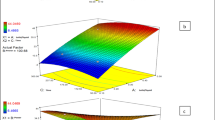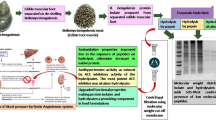Abstract
The aim of this work was to evaluate the ability of broken rice, an underutilized industrial by-product, as a potential functional and health promoting ingredient. With this purpose, the ability to inhibit the angiotensin converting enzyme and renin of a rice protein hydrolyzate (RPH) obtained from a high-protein variety of broken rice (var. Nutriar FCAyF) was analyzed (IC50 = 0.87 and 2.7 mg/mL, respectively). RPH was separated by gel permeation chromatography and in a second purification step by RP-HPLC. The sequence of antihypertensive peptides presented in two RP-HPLC fractions was analyzed. Peptides capable of interacting with the active sites of both enzymes were identified. In this study, we demonstrate that the hydrolysis treatment improves functional and biological properties of rice proteins. Protein preparations obtained from a by-product of rice industry, such as broken rice, are a promising ingredient with potentially good biological properties.



Similar content being viewed by others
References
States U (2017) Statistics of grain and feed. Agric Stat:1–49. https://www.nass.usda.gov/Publications/Ag_Statistics/2017/Chapter01.pdf
Moreno P (2016) Cadena del arroz. Minist Agroind Argentina 15. http://www.alimentosargentinos.gob.ar/HomeAlimentos/Cadenas%20de%20Valor%20de%20Alimentos%20y%20Bebidas/informes/Ficha_anual_arroz_sept_2017.pdf
Food and Agriculture Organization (2018) FAO rice market monitor. http://www.fao.org/3/I9243EN/i9243en.pdf
Pinciroli M, Vidal AA, Añón MC, Martínez EN (2009) Comparison between protein functional properties of two rice cultivars. LWT - Food Sci Technol 42:1605–1610. https://doi.org/10.1016/j.lwt.2009.06.003
Paraman I, Hettiarachchy NS, Schaefer C, Beck MI (2006) Physicochemical properties of rice endosperm proteins extracted by chemical and enzymatic methods. Cereal Chem 83:663–667. https://doi.org/10.1094/CC-83-0663
Phongthai S, D’Amico S, Schoenlechner R et al (2018) Fractionation and antioxidant properties of rice bran protein hydrolysates stimulated by in vitro gastrointestinal digestion. Food Chem 240:156–164. https://doi.org/10.1016/j.foodchem.2017.07.080
Zhao Q, Xiong H, Selomulya C, Chen XD, Zhong H, Wang S, Sun W, Zhou Q (2012) Enzymatic hydrolysis of rice dreg protein: effects of enzyme type on the functional properties and antioxidant activities of recovered proteins. Food Chem 134:1360–1367. https://doi.org/10.1016/j.foodchem.2012.03.033
Kannan A, Hettiarachchy NSNS, Lay JOJO, Liyanage R (2010) Human cancer cell proliferation inhibition by a pentapeptide isolated and characterized from rice bran. Peptides 31:1629–1634. https://doi.org/10.1016/j.peptides.2010.05.018
Zhang H, Yokoyama WHWH, Zhang H (2012) Concentration-dependent displacement of cholesterol in micelles by hydrophobic rice bran protein hydrolysates. J Sci Food Agric 92:1395–1401. https://doi.org/10.1002/jsfa.4713
Shobako N, Ogawa Y, Ishikado A, Harada K, Kobayashi E, Suido H, Kusakari T, Maeda M, Suwa M, Matsumoto M, Kanamoto R, Ohinata K (2018) A novel antihypertensive peptide identified in thermolysin-digested rice bran. Mol Nutr Food Res 62:1–7. https://doi.org/10.1002/mnfr.201700732
Taniguchi M, Kameda M, Namae T, Ochiai A, Saitoh E, Tanaka T (2017) Identification and characterization of multifunctional cationic peptides derived from peptic hydrolysates of rice bran protein. J Funct Foods 34:287–296. https://doi.org/10.1016/j.jff.2017.04.046
Agyei D, Bambarandage E, Udenigwe CC (2018) The role of bioinformatics in the discovery of bioactive peptides. In: Reference module in food science. Elsevier, Amsterdam, pp 1–9
Meng X-Y, Zhang H-X, Mezei M, Cui M (2011) Molecular docking: a powerful approach for structure-based drug discovery. Curr Comput Aided-Drug Des 7:146–157. https://doi.org/10.2174/157340911795677602
Juliano BO (1985) Polysacharides, proteins and lipids of rice. In: Rice: chemistry and technology, 2nd edn. American Association of Cereal Chemists, St Paul, pp 59–174
Dinnella C, Gargaro MT, Rossano R, Monteleone E (2002) Spectrophotometric assay using o-phtaldialdehyde for the determination of transglutaminase activity on casein. Food Chem 78:363–368. https://doi.org/10.1016/S0308-8146(02)00109-7
Quiroga AV, Aphalo P, Nardo AE, Añón MC (2017) In vitro modulation of renin-angiotensin system enzymes by amaranth (Amaranthus hypochondriacus) protein-derived peptides: alternative mechanisms different from ACE inhibition. J Agric Food Chem 65:7415–7423. https://doi.org/10.1021/acs.jafc.7b02240
Schägger H (2006) Tricine-SDS-PAGE. Nat Protoc 1:16–22
Hurst PL, Lovell-Smith CJ (1981) Optimized assay for serum angiotensin-converting enzyme activity. Clin Chem 27:2048–2052
Ferri M, Graen-Heedfeld J, Bretz K, Guillon F, Michelini E, Calabretta MM, Lamborghini M, Gruarin N, Roda A, Kraft A, Tassoni A (2017) Peptide fractions obtained from rice by-products by means of an environment-friendly process show in vitro health-related bioactivities. PLoS One 12:e0170954. https://doi.org/10.1371/journal.pone.0170954
Adebiyi AP, Adebiyi AO, Ogawa T, Muramoto K (2008) Purification and characterisation of antioxidative peptides from unfractionated rice bran protein hydrolysates. Int J Food Sci Technol 43:35–43. https://doi.org/10.1111/j.1365-2621.2006.01379.x
Condés MC, Scilingo AA, Añón MC (2009) Characterization of amaranth proteins modified by trypsin proteolysis. Structural and functional changes. LWT - Food Sci Technol 42:963–970. https://doi.org/10.1016/j.lwt.2008.12.008
Ajibola CF, Fashakin JB, Fagbemi TN, Aluko RE (2013) Renin and angiotensin converting enzyme inhibition with antioxidant properties of African yam bean protein hydrolysate and reverse-phase HPLC-separated peptide fractions. Food Res Int 52:437–444. https://doi.org/10.1016/j.foodres.2012.12.003
Amagliani L, O’Regan J, Kelly AL, O’Mahony JA (2017) The composition, extraction, functionality and applications of rice proteins: a review. Trends Food Sci Technol 64:1–12. https://doi.org/10.1016/j.tifs.2017.01.008
Fabian C, Ju YH (2011) A review on rice bran protein: its properties and extraction methods. Crit Rev Food Sci Nutr 51:816–827. https://doi.org/10.1080/10408398.2010.482678
Aluko RE (2019) Food protein-derived renin-inhibitory peptides: in vitro and in vivo properties. J Food Biochem 43:1–12. https://doi.org/10.1111/jfbc.12648
Aluko RE (2015) Antihypertensive peptides from food proteins. Annu Rev Food Sci Technol 6:235–262. https://doi.org/10.1146/annurev-food-022814-015520
Aluko RE (2015) Structure and function of plant protein-derived antihypertensive peptides. Curr Opin Food Sci 4:44–50
Takahashi S, Tokiwano T, Hata K et al (2010) The occurrence of renin inhibitor in rice: isolation, identification, and structure-function relationship. Biosci Biotechnol Biochem 74:1713–1715. https://doi.org/10.1271/bbb.100233
Alashi AM, Blanchard CL, Mailer RJ, Agboola SO, Mawson AJ, He R, Malomo SA, Girgih AT, Aluko RE (2014) Blood pressure lowering effects of Australian canola protein hydrolysates in spontaneously hypertensive rats. Food Res Int 55:281–287. https://doi.org/10.1016/j.foodres.2013.11.015
Udenigwe CC, Li H, Aluko RE (2012) Quantitative structure-activity relationship modeling of renin-inhibiting dipeptides. Amino Acids 42:1379–1386. https://doi.org/10.1007/s00726-011-0833-2
Berek D (2010) Size exclusion chromatography – a blessing and a curse of science and technology of synthetic polymers. J Sep Sci 33:315–335. https://doi.org/10.1002/jssc.200900709
Saito Y, Ohura S, Kawato A, Suginami K (1997) Prolyl endopeptidase inhibitors in sake and its byproducts. J Agric Food Chem 45:720–724. https://doi.org/10.1021/jf9604706
Masuyer G, Schwager SLU, Sturrock ED, Isaac RE, Acharya KR (2012) Molecular recognition and regulation of human angiotensin-I converting enzyme (ACE) activity by natural inhibitory peptides. Sci Rep 2:1–10. https://doi.org/10.1038/srep00717
Natesh R, Schwager SLU, Sturrock ED, Acharya KR (2003) Crystal structure of the human enzyme – lisinopril complex. Nature 421:1427–1429. https://doi.org/10.1038/nature01370
Morris GM, Huey R, Lindstrom W, Sanner MF, Belew RK, Goodsell DS, Olson AJ (2009) AutoDock4 and AutoDockTools4: automated docking with selective receptor flexibility. J Comput Chem 30:2785–2791. https://doi.org/10.1002/jcc.21256
Acknowledgements
The authors acknowledge the contribution of Dra. Nora E. Martínez to this work.
Funding
This work was supported by Agencia Nacional de Promoción Científica y Tecnológica (ANPCyT, Argentina), Project PICT-2012- 0937.
Author information
Authors and Affiliations
Corresponding author
Ethics declarations
Conflict of Interest
The author declare that they have no conflict of interest.
Additional information
Publisher’s Note
Springer Nature remains neutral with regard to jurisdictional claims in published maps and institutional affiliations.
Electronic Supplementary Material
ESM 1
(DOCX 122 kb)
Rights and permissions
About this article
Cite this article
Pinciroli, M., Aphalo, P., Nardo, A.E. et al. Broken Rice as a Potential Functional Ingredient with Inhibitory Activity of Renin and Angiotensin-Converting Enzyme(ACE). Plant Foods Hum Nutr 74, 405–413 (2019). https://doi.org/10.1007/s11130-019-00754-6
Published:
Issue Date:
DOI: https://doi.org/10.1007/s11130-019-00754-6




